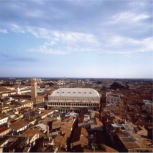
Padua
Due to its excellent location, the city is a natural hub for trade and logistics. The city’s economy is thriving as a result of the presence of numerous enterprises of every kind, mainly industrial ones, but also from tertiary and primary economic sectors.
Energy, mobility and industry are the main sectors responsible for the high concentration of pollutants affecting the air quality in Padua. Moreover, other natural factors also influence the air quality in the Po Valley, such as the meteorological conditions and the topography of the area. Therefore, the city’s strongest efforts lie in reducing all the resources that generate air pollution. On–going monitoring shows that Padua has reduced CO2 emission by 37%, result which indicates that the city is paving its way to carbon neutrality by 2020.
The University of Padua is one of Europe’s oldest, being established in 1222. There are 57.646 students attending this multi-disciplinary university that aims at constantly updating its services in order to meet the ever-changing needs of the labour market in Padua and beyond. Next to one of the university buildings, the world's first university botanical garden is situated, dating since1545. It became the archetype of botanical gardens and, as such, in 1997 it was listed by UNESCO as a World Heritage Site. The original territory of the gardens was expanded and a new building was erected, for the Gardens of Biodiversity.
